Wow, Jennie Livingston’s incredible documentary Paris is Burning, about vogueing gangs and balls, is on YouTube. This was a formative New York City film for me. I’ve given talks about it in church, even. I found it one of the purest most universal expressions of the common motivations that drive all our lives, whether we’re gay, black, homeless, cross-dressing street hustlers or not–love, family, belonging, comfort, security, survival, normalcy, respect–all things I take my entitlement to utterly for granted.
It’s one of the biggest film world mystery/disappointments that Livingston hasn’t made more movies. Guess I need to circle back and watch Who’s on Top?, her Busby Berkeley-style musical lesbian sex comedy. Don’t know how I’ll work that one into the sunday school lesson.
Paris is Burning 1/11 [youtube via smashingtelly.com and kottke]
I Like Big Balloons, I Cannot Lie
William Assman was a balloon racer from St. Louis who attempted several times to win the John Gordon Bennett Trophy, a flying endurance competition to spur development of gas balloon technology, which was founded in 1906 by the sporty owner of the New York Herald.
Miss Sofia was one of Assman’s earlier balloons, probably from 1910-11. In the 1910 International Balloon Race, Assman rode as aide on the German balloon Harburg II and sustained multiple injuries when it crashed into a Canadian lake. [That’s how the race was run; the balloons would just go as far as they could, then land, and report their position. Farthest/last one flying won.]
He was flying the Miss Sofia in 1911, though.
But not in 1912, when the NY Times reported his balloon, the St Louis IV, was eliminated from the qualifying round with technical problems. By 1913, he was flying the Miss Sophia II [sic], which had a valve torn out by strong wind. Said the Times: “When he found he could not start, he took his pocketknife and cut his $1,800 balloon to pieces.”
You’d think that even though he never won the Bennett Trophy, a daring balloonist named Assman would be more famous than he currently appears to be. [via andy]
James Turrell On Earth Shadow, Anti-Twilight, And The 15-Minute Museum Experience
 The newly redesigned Design Observer would’ve been awesome even without hosting the archive of Places: Forum of Design For the Public Realm, a print journal published by the architecture faculties at MIT and UC Berkeley from 1983 until Spring 2009.
The newly redesigned Design Observer would’ve been awesome even without hosting the archive of Places: Forum of Design For the Public Realm, a print journal published by the architecture faculties at MIT and UC Berkeley from 1983 until Spring 2009.
One of the first pieces to be republished is an interview from 1983 with James Turrell conducted by Kathy Halbreich, Lois Craig, and William Porter. Much of the discussion is about Turrell’s “most ambitious current project,” Roden Crater, which is only now nearing completion, 25 years later. A couple of interesting parts, the first of which is only interesting insomuch as it kind of puts paid to Michael Kimmelman’s recent [sic] lament over dwindling museumgoer attention spans and how people only stand in front of the Mona Lisa long enough to take a picture. Turns out a) duh, b) duh, and c) Turrell’s been looking at looking for decades now:
Places: You’re really challenging the 15-minute museum experience. There’s a requirement, there’s a demand in this to be somewhere.
Turrell: Well, if you don’t do that, then, it’s just the emperor’s clothes. Either you do the work or you forget it. There is a price of admission and most people don’t pay it.
Now for something I didn’t know, even after decades of looking:
For instance, there’s one light event that’s every important to me: the rise of the earth’s shadow. When the sun goes down in the West and you look to the East on a clear day you’ll see this pink line, with white silvery-blue below. Actually, you’re looking at the earth’s shadow advancing up in the sky in the East as the sun goes down in the West, so you see the earth’s shadow projected in the atmosphere. What you see underneath is night rising. Night doesn’t fall. It rises.
Really? Really. With formulas and diagrams and everything. The anti-twilight arch, or as the Victorians called it, the “Belt of Venus,” is also new to me. If there’s anything more banally sublime than the Mona Lisa, it’s a beautiful sunset. And yet there you go.
Sounds like it’s time to break down and read The Nature of Light and Colour in the Open Air, Marcel Minnaert’s almost quixotically exhaustive and hugely influential attempt to pin down and explain all the phenomena of light in the world. Turrell mentioned it last Spring.
The photo above of a 2001 space shuttle launch at sunset shows part of the exhaust plume in the earth’s shadow, and part of it illuminated by the sun. Apparently, the shadow of the plume itself, which only appears to connect with the moon, is called the Bugeron Effect, [or Burgeron Effect?] which is apparently different from the Bergeron Effect . So that’s like three or four things I didn’t know, and one I still don’t. here’s a normal picture of the earth shadow rise. [via nasaimages.org]
Posted [sic] 07.15.83 An Interview With James Turrell [places.designobserver.com]
Frosty Myers Winners

Before I realized that if I wanted to see an exhibit of a 100-ft silver balloon, I’d have to make it myself, I was still just ruminating on art I hoped/wished someone would make. One of those projects I want/need to see is a re-staging of the Los Angeles Times photo of the panicked air raid searchlights that criss-crossed the sky on the night of Feb. 25, 1942. Six civilians died in that apparent, still unexplained false alarm, and the Times’ caption on the photo above described how the “searchlights built a wigwam” over the city. Wouldn’t that be fantastic?
Well, now I wonder if there is someone to get to do it.
16 Miles pointed to an awesome 2001 Art in America article by Suzaan Boettger on Sculpture in Environment, a pioneering New York City-wide show of public sculpture organized by Sam Green, the director of the ICA in Philadelphia, which took place in October 1967.
The main focus of Boettger’s article is an intriguing and prescient unmonumental work by Claes Oldenberg, and Robert Smithson’s seminal roadtrip article/work, “The Monuments of Passaic,” which [not] coincidentally, he made the day before. And the hook for 16 Miles’ post is the death of Tony Rosenthal, whose Alamo cube still spins where it was shown, in Astor Place. But there are other great details: Oldenberg had first proposed creating a traffic jam; Robert Morris’s jets of steam proposal was considered “too ephemeral.” Isamu Noguchi was still pitching his playground idea [“too expensive.”] Alexander Calder liked to help the Negros. &c. &c.
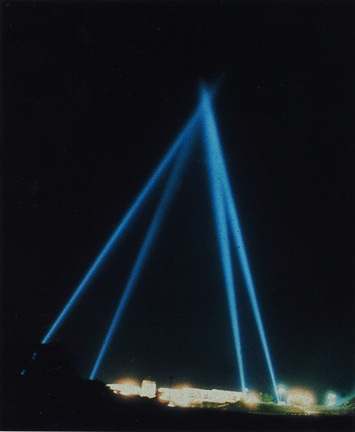
But anyway, Boettger mentions this “a nocturnal event by Forrest Myers, who projected four carbon arc searchlights from Tompkins Square Park.” It’s not clear what they were called, but this description from a 2006 Art in America profile of Frosty Myers explains what these sculptures were:
“Searchlight Sculptures,” nighttime installations of carbon-arc searchlights that were sited at the four corners of Tompkins Square Park in the East Village in 1966, in Union Square in 1969, in a park in Fort Worth in 1979, and elsewhere. The beams tent upward to join at an apex in the manner of a vast pyramid.
Elsewhere included Artpark in Lewiston, NY, where Myers created a Searchlights pyramid in 1975 [see above]. You must admit, it does look very wigwammish.
You may know Myers from such previous greg.org appearances as: being instrumental in E.A.T. and the art/tech collaborative’s ambitious artfest-in-a-mirrored-dome, the Pepsi Pavilion at the Osaka ’70 Expo. And maybe being one of six artists whose work was secretly smuggled onto the moon on the Apollo 12 lunar module.
Remembering Tony Rosenthal, Remembering “Sculpture in Environment” [16miles.com]
A Found Weekend, 1967: Public Sculpture and Anti-Monuments, Art in America, Jan. 2001 [art in america via findarticles]
[Searchlights imagevia ekac.org]
And Now A Report On The Latest Trends And/Or Story Ideas From The World Of Architecture!
The funny thing is, I think my problem is I couldn’t have made something like this up:
Hi Greg,
Here’s a trend and story idea for the growing number of architecture company cars piling up from economic downsizing: The majority of small businesses and firms lease cars for tax purposes. However, owners must still make payments on those cars if the leases are stuck in park from staff cutbacks. But a new program is now helping small firms get unused car leases off the books giving finances a new lease on life.
–Small business owners have had to downsize staff, leaving many of these car leases sitting idle in the parking lot (but still requiring monthly payments).
–Owners can’t sell the lease and if they turn them back in to the bank they will get slapped with early contract termination fees upwards of $10,000 per car.
–A new Small Business Car Release program helps architecture firm owners ditch the lease by transferring the contract to someone else (most popular service being PressReleaseSender.com).
–The car lease company is involved in the program, it takes about 2-3 weeks for the transfer and removes the small business owner from obligations to make the monthly payments.
–Paying for unused car leases is salt on the wound considering rising health care costs and less credit available from banks.
Sources To Quote:
–Sergio Stiberman, CEO and founder of PressReleaseSender.com, to discuss the new Small Business Car Release program.
–Also speak with the executive director of Auto Fleet Leasing on industry trends and number of small businesses leasing vehicles.
Additional Story Titles:
Company Helps Small Business Unload Excess Car Leases
Small Business Help Allows For Immediate Release of Company Cars
Small Business Relief When Company Car Can’t Start Up
Program Helps Small Business Move Company Cars Stuck in Park
Program Offers Small Business Relief for Unused Car Leases
Unemployment Leaves Small Business on Company Lease Collision Course
Unused Company Car Leases Eat Into Already Thin Margins
So many wonderful titles to choose from, I need an intern to help me decide!
Lawrence Kocher’s Black Mountain College?
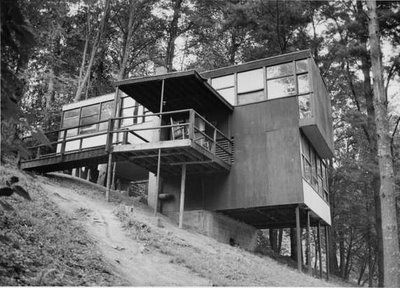
I stumbled across Lawrence Kocher and Albert Frey’s Aluminaire House last night while trying to figure out who built this house at Black Mountain College. It’s from the Charles Olson Research Collection at UConn, and was posted at An Ambitious Project Collapsing [get some permalinks there, buddy!]
Olson ran BMC from 1951 until its closing in 1956. But though it’s in the Olson BMC portfolio, the photo is credited to Frank Ballard, and is dated 1977, and is taken at a place called Camp Rochmont. So what gives?
Well, Camp Rochmont is actually Camp Rockmont, a non-denominational Christian boys camp, and it is Black Mountain College. When the school closed, 550 acres around Lake Eden was sold and turned into the camp. Another 60 acres full of BMC buildings is now Lake Eden Events, which hosts concerts and gatherings large and small.
As editor of The Architectural Record, A. Lawrence Kocher had recommended to BMC in the late 1930s that they collaborate with Walter Gropius and Marcel Breuer, fresh from the Bauhaus, to design a new modernist campus at Lake Eden, a failed, half-built resort complex. When fundraising fell through, Kocher himself began designing a building and planning out the rest of the site beginning in 1940. He was apparently in residence from 1940-43, teaching architecture and leading BMC’s trademark student building projects.
Of all the architects associated with BMC, Kocher seems the most likely architect for structure above. He designed two houses in 1940-41: one for the music teacher, the Viennese composer and early Schoenberg student Heinrich Jalowetz [now called the Sequoia Cottage, and available for $250/night, but not this year], and a 2-story house “for the kitchen staff and other black workers.” [It was still the segregated South, after all.
In The Arts at Black Mountain College, Mary Emma Harris described the Jalowetz house design as “based on four-by-eight-foot plywood panels,” a favorite material of Kocher’s. As the picture clearly shows, the house above is also designed around plywood sheet dimensions. And don’t the raised base and ribbon windows kind of give off an Aluminaire vibe?
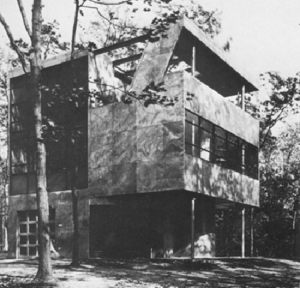
The only house on this map of the Lake Eden Campus I can map it to is #9, the Service House, which is indeed on the Rockmont side of the lake.
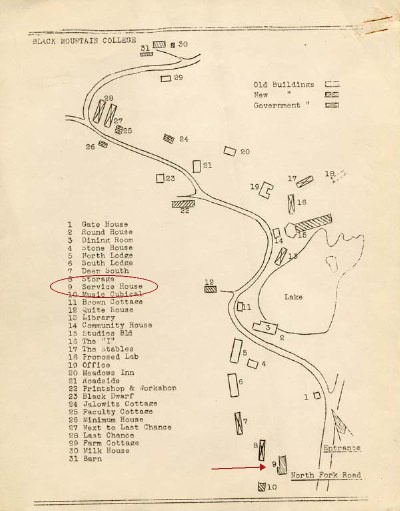
For all its seemingly awesome, modest simplicity, something called a Service House, built for staff in a far corner of BMC sounds unlikely to have much more documentation–and probably doesn’t appear too often in the typical photographic record of the day. I’m not too optimistic about finding out much more, but I’d love to be wrong.
Who What? Kocher & Frey’s Aluminaire House?
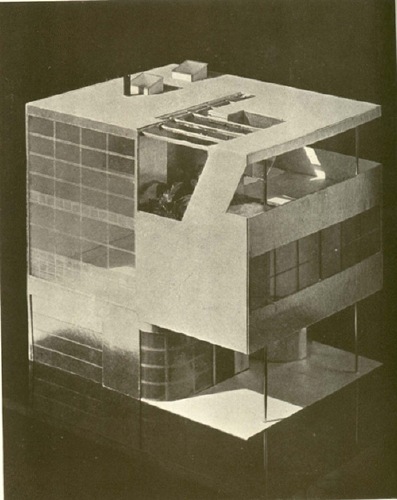
Let me get this straight: the first modernist prefab in the US; one of two US houses included in Phillip Johnson’s 1932 International Style exhibition at MoMA [the other: Neutra’s Lovell House]; built in 10 days from off-the-shelf industrial materials, with no formal plans or blueprints; Albert Frey’s first US project; bought and disassembled in hours, then saved and bastardized by Wallace K. Harrison; quoted nearly perfectly–concept, materials, and form–by Kieran Timberlake in their Cellophane House; and yet somehow Aluminaire House itself was not included in “Home Delivery,” MoMA’s 2007 show on the history of the modern prefab Please tell me I just missed it or blocked it from my memory.
But I’m hardly the only one.
Lawrence Kocher was editor of Architectural Record and later involved with Black Mountain College. The 27-year old Albert Frey was fresh off the boat from Le Corbusier’s studio. They whipped up Aluminaire House from donated parts and materials for a 1931 building show and Architectural League exhibition at Grand Central Palace, an expo hall that filled the block between 46th and 47th streets and Park and Lex.
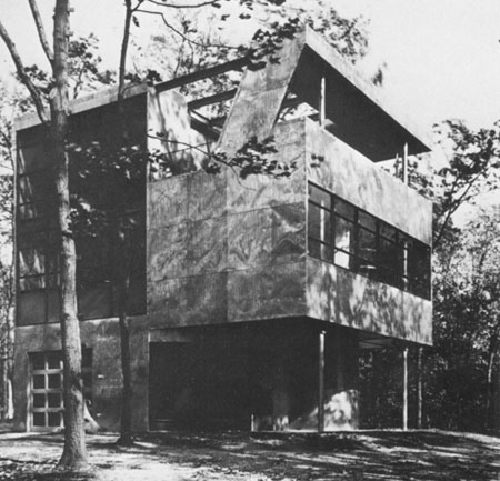
Kocher’s concept was a light-filled, modernist prefab house made of innovative, industrial, mass-produceable materials: aluminum, steel and glass. The 3-story, 5-room, 28×22-ft, 1,200 sf building was barely more than a mockup, an exhibition pavilion. Frey later compared it more to a refrigerator than a building in its construction; it was light steel bolted together with nuts and washers and skinned in ribbon windows and corrugated aluminum, a material Frey would use extensively in California. The floor was ship decking covered in linoleum. Interior walls were rayon fabric. It was supported on five aluminum pilotis.
The main living space [LR/DR, Kit, MBR, BA] was on the second floor. The living room was double height, open to a partially enclosed library/2nd bedroom on the third floor, which also had a terrace. A second bathroom with shower was cantilevered over the living room, which frankly sounds like a joke.
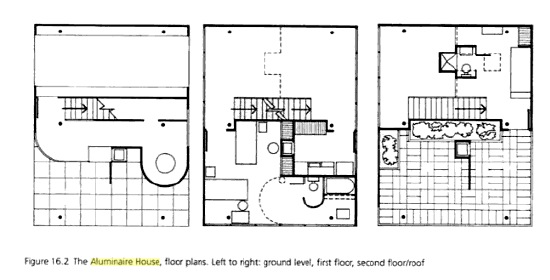
Harrison bought the Aluminaire House for a thousand dollars after the expo ended, and reassembled it at his house on Long Island. In ’32, Johnson showed the house in the International Style exhibition, but didn’t include it in the catalogue. Harrison proceeded to enclose the ground and third floors and add on some circular structures, rendering the house nearly unrecognizable.
Which is why it was almost demolished in 1987-8 when Harrison’s estate was chopped up and developed. The architecture department of the New York Institute of Technology took the Aluminaire House on as a school project. They studied and dismantled it, then eventually reassembled and restored it on a new pad on their Central Islip campus. Which looks to be about 10 minutes south of Exit 55 on the LIE, within easy pilgrimage visiting by every design snob in the Hamptons.
And yet, no one really seems to care or know about it. In a brief blurb about a 1998 Arch. League show on restoring Aluminaire House, Herbert Muschamp got the location and story of the house wrong. No one who writes about it sounds like they’ve actually seen it. There aren’t any contemporary photos of it online, only one shot from Harrison’s yard.
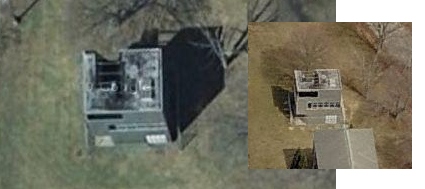
It’s on Google Maps, of course, and that’s Microsoft’s Bird’s Eye view on the right. But no mention of it on NYIT’s site. [The architecture department was moved from Islip to a campus in Old Westbury, so if it served any academic purpose before, the Aluminaire House seems kind of orphaned now. A 2007 messageboard post said that it was to be relocated as part of a redevelopment/selloff of part of the campus. If it hasn’t happened yet, I’m sure it won’t happen for a while.
But it sounds to me like there’s an unloved, unappreciated pile of historic modern awesomeness in the middle of Long Island that needs to be liberated and returned to loving domestic use. At the very least, will someone take half an hour on the way to the beach and go shoot some freakin’ photos?
The only lengthy discussion of Aluminaire House I can find online: docomomo’s 1998 Modern Movement Heritage by Allen Cunningham [google books]
Tim Burton X Donald Judd
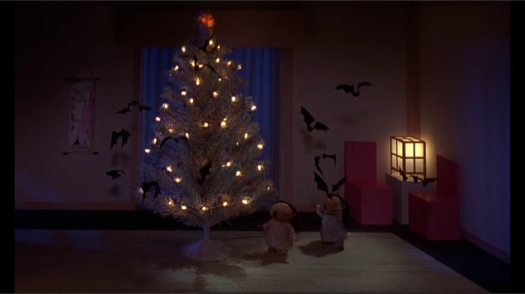
Tim Burton was at MoMA yesterday, talking to media folk about a film dept. retrospective of his work, which includes an exhibition this fall of sketches, storyboards, props, puppets, etc. from his wacked out output.
I wasn’t in town for the q&a [here’s a movieline writeup via MoMA’s Twitter] , but the confluence of Burton and MoMA reminded me of one of my favorite art geek moments: spotting Donald Judd chairs in the background of a 2-second shot in the director’s 1993 stop action animated film, Nightmare Before Christmas.
That’s them in the corner there, in a montage where Jack ruins Christmas all over town. Here’s a close-up. They’re pink!

I had really just begun getting interested in Judd’s furniture a year or so before this, so I was pretty attuned. In fact, several months after seeing the movie, I met Rainer Judd to talk about buying some pieces, about differences or changes with the handling of furniture that might follow her father’s untimely death.
As we chatted, I mentioned the chairs Tim Burton had put in the movie, and she was pretty surprised. She knew Burton, it turned out, and knew he was a fan of the work. And yet, she’d never heard about the chairs–or chairs inspired by the chairs–making a cameo.
Never did hear anything else about it. Hope I didn’t get him into trouble.
On LACMA Killing Its Film Program [To Save It?]
Regular readers of greg.org know it, but I’ll say it upfront: I’m Team MoMA. I’ve supported the museum for years–I feel like I grew up in it, art-wise. And film-wise. Right now, MoMA’s film department and programming are stronger than I can ever remember. It feels absolutely vital, critical. And even when the old timers SHHH! people for breathing too loud in the theater, it’s great to see a movie there.
And yet the Bing theater at LACMA is even nicer. And yet, LACMA is suspending [i.e., killing] its film program. In Los Angeles. It’s just mindboggling. They have to be planning a complete, and somehow different reboot, a makeover of some kind for which Michael Govan’s only plausible path is going cold turkey.
Two home team analogies: MoMA’s Projects series, which lived for a very long time just off the lobby as a small gallery for anointing emerging artists, but which was eventually brought back to the Taniguchi building as a roving showcase for [basically] New York debuts by global artists. Generally speaking, it seems to be working.
The other is more directly film-related: the Modern caught a lot of flak for closing its film stills collection, squeezing out the longtime curator and librarian–who happened to be active in the employee’s union, and the whole thing went down around the time of the staff strike–and shipping the whole thing off to the film center in Pennsylvania. It was a controversial action, to say the least, but [film] life goes on. What the net impact is, nearly a decade later?
So yeah, I’m alarmed by Govan’s decision and by Kenneth Turan’s outrage over it. But I also have to hope that some kind of substantial film program will return, even if it’s new and different and takes a while. Because I can’t imagine otherwise.
LACMA slaps film in the face [latimes]
In The Beginning There Was Not Just Tron
So while we were staring slack-jawed at the computer graphics in Tron, Loren Carpenter had already produced and shown Vol Libre, this incredible fractal mountain flythrough animation two years earlier at SIGGRAPH–and had been hired on the spot by Industrial Light & Magic? And you’re only getting around to uploading it now, nearly 30 years later?
Vol Libre from Loren Carpenter on Vimeo.
What else you hiding, Pioneers of Computer Animation? [via kottke]
Microarchitecture On ebay.fr, Only Two Days Left!
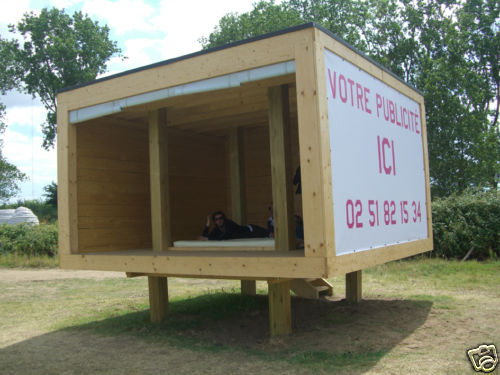
Estuaire is the three-time biennale in beta for the Nantes region. This year, the second incarnation includes I.C.I., Instant Carnet Island, a habitable, riverfront collection of micro-architecture which is for rent–EUR10/person/night, bring your sleeping bag–and for sale.
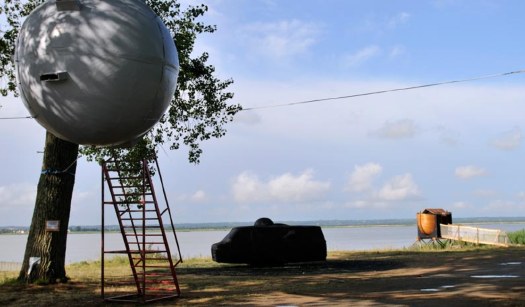
Several of the structures have been put on French eBay. Available items include both Antonin Sorel’s L’étoile de l’amour [above, left], which is several puns at once on L’étoile de la mort [the Death Star, though in Star Wars ep. IV, it was actually called l’Etoile Noire]; and Damien Chivialle’s ark for “amoreux hedonistes” [above, right]; but not, alas, Ant Farm’s time capsule/video lounge recreation of their Media Van [above, center], which could probably teach the kiddies a thing or two about hedonistes, amiright?
There are less than two full days left, and so far, with only one 16-seat picnic table by the Dutch design firm 24h Living meeting the reserve, the whole thing seems destined to be a primarily conceptual exercise.
Unless people start bidding now!
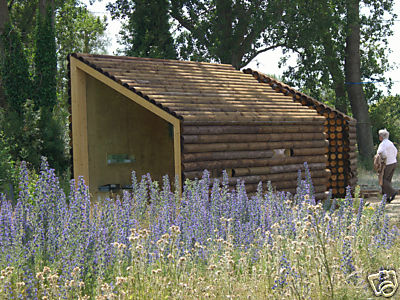
The Flake House [above, currently EUR2310] by the Paris architects OLGGA is pretty rustic-slick, about as practical as a folly can get; and Dre Wapenaar’s Treetent [current bid: EUR2000] is a classic. But I think I’d take Spanish artist Alicia Framis’s Billboard House [top] first. The opening bid is just EUR1000 [including breakdown and loading, but not shipping or reassembly].
Originally conceived for the Land project Rirkrit Tiravanija organizes in Thailand, Billboard House consists of just three billboards and a raised floor. It threads the utopian needle very nicely. It’s unprecious and low-tech, a totally plausible-seeming affordable housing solution–for folks living the Thai, along the side of the road, do all your cooking and socializing and hygienic activities outdoors lifestyle.
Estuaire 2009 | Instant Carnet Island runs through Aug 16 [estuaire.info via thingsmagazine]
check out Estuaire09’s items on eBay France, auctions end July 31 Paris time [ebay.fr]
Billboardhousethailand (2000) [aliciaframis.com]
update: in the end, everything had at least one bid, but only two of 24h Living’s three tables sold.
Sarah In The Sky With Diamonds
Hah, Shatner reads Sarah Palin’s exit speech on Conan.
I’d love to see this poem set to music. And then flash-animated.Holy smoking man, I’d forgotten about his “Rocket Man”:
[via felix]
Dance, Memory
I’m surprising myself by how much I feel the loss of Merce Cunningham, or more precisely, how much more acutely I’m feeling an appreciation for his work right now.
From the LA Times’ obituary by Lewis Segal:
“When you work on something that you don’t know about, how do you figure out what’s right for that moment?” he asked rhetorically in the 2005 Times interview. “Using chance can be a way of looking at what you do in another way without depending always on your memory. It helps something else to come out that otherwise you wouldn’t have known about.”
And from Alastair Macaulay, the NY Times dance critic who’s obviously been deeply contemplating for years having to write Merce’s obit at some point:
Mr. Cunningham often spoke and wrote movingly about the nature of dance and would laugh about its maddening impermanence. “You have to love dancing to stick to it,” he once wrote. “It gives you nothing back, no manuscripts to store away, no paintings to show on walls and maybe hang in museums, no poems to be printed and sold, nothing but that single fleeting moment when you feel alive.”
On the other hand, there’s always this hilariously insipid interview by R. Couri Hay from a 1974 Cunningham-Cage party at Louise Nevelson’s place to lighten the mood. My favorite “question” is around 27:00: “Perhaps, Mr Cage can tell- can we ask you about– can you tell us some of the–interesting things that happen when you were working with–Mr Cunningham–tell us all about some of the–incredible little things that must have happened when you were working out some, uh, new–fabulous things?”
Nam June Paik On Art & Boxing
Was watching this ancient panel discussion, “Time and Space Concepts in Music and Visual Art,” from Pleiades Gallery in 1978 with Merce Cunningham, but then I totally fell for Nam June Paik all over again instead. A couple of pull quotes:
In any other profession like lawyers, dentists, sanitation workers, or teachers, if you do fairly well, slightly above average, you can make a living. But only in art and heavyweight boxing, you have to be top five to pay your rent.
[laughter]
It’s strange, especially because in heavyweight boxing, you know more or less who wins. The fight can be fixed, but not as easily as in the art world.
And this one, where Paik talks about peoples’ complaints that video art is boring, and that it would be hard to write a PhD on the history of video art, because all the material you’d have to sit through would take a hundred years. It’s not the random access of an encyclopedia vs the sequential access of video, though, that’s strikes a particular chord, but the realization that the panel’s participants–Cage, Paik, Cunningham–are now gone [stay healthy, Richard Kostelanetz and Dore Ashton!]:
Life, we cannot repeat. Life is sequential access. However, videotape is changing that: life as a sequential access.
If you freeze a time and retrieve them. So you keep certain access–1967, 1955–frozen. Like an icebox. You can go access cheese, butter, eggs. And you can go back to your twentyhood, thirtyhood, childhood, in random access. That, videotape is doing. So the beauty of videotape produced now will be appreciated in 2000. It’s like antique hunting.
On another note, it’s kind of comforting/ennervating to see that the medium of panel discussion is still sequential, often boring, and characterized by audience essays in the form of a question.
Time and Space Concepts in Music and Visual Art (Part I) (1978) [ubu]
Merce Cunningham & John Cage, Variations V
Bell Labs engineer Billy Kluver helped design photocells so that dancers triggered lights and sounds and films [with images by Stan VanDerBeek and Nam June Paik.] According to
media art net, this excerpt was from a 1965 TV performance of the work in Hamburg. [mediaartnet.org]
Related: Merce Cunningham video at Ubu

